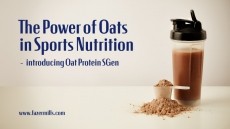Study supports phosphate loading for endurance activities at altitude

In the first trial to assess the effect of sodium phosphate supplementation on athletes under hypoxic (oxygen deficient) conditions, researchers from Poland have found that six-day supplementation promoted improvements in the efficiency of the cardiorespiratory system.
“Our study revealed that short-term supplementation sodium phosphate supplementation leads to a decrease in heart rate, and increase in stroke volume, and an improvement in oxygen pulse during exercise at low to moderate intensity under hypoxia,” wrote the researchers in the journal Nutrients.
Over the years, it has been suggested that supplementation with phosphate salts may have a positive effect on athletic performance. However, in 2021, phosphate was classified by the Australian Institute of Sport as a substance for which the scientific evidence does not support a benefit amongst athletes or no research has been conducted to form an informed opinion about the substance. Meaning more research is needed to determine the effectiveness of phosphate supplementation in athletes and to establish the best practice protocol in this regard.
To date, several studies have supported the athletic performance benefits of phosphate salt supplementation in normal oxygen conditions. These have shown that phosphate loading leads to an increase in maximal oxygen uptake and anaerobic threshold, better time trial performance, and improvements of the repeated-sprint ability. These benefits were aided by an increase in stroke volume (the volume of blood pumped out of the left ventricle of the heart during each systolic cardiac contraction) and a decrease in heart rate.
However, no studies have analysed its effect under hypoxic conditions. This is important because exercise capacity is lower under hypoxia, which can affect athletes undertaking activities such as cycling, triathlon, running and skiing at altitude. The body responds to hypoxia by increasing the heart rate, which leads to a compensatory increase in cardiac output that further increases demand for oxygen. Lowering the heart rate and increasing stroke value reduces myocardial demand for oxygen. Therefore, the authors of the current study hypothesised that an improvement in myocardial function following phosphate loading may be beneficial in hypoxic conditions.
A study with two aims
Supported by a grant from the National Science Centre of Poland, the current study had two aims. The first was to investigate the effect of six-day sodium phosphate supplementation on cardiorespiratory variables in cyclists during exercise in hypoxic conditions.
The second aim was to analyse whether sodium phosphate supplementation would affect mechanical efficiency - the ability to transfer the energy expended into exercise performance - under hypoxia. In 2016, a Spanish team reported that sodium phosphate intake improves energy efficiency (reduction of oxygen consumption at the same workload) during exercise at low intensity in normal conditions. Therefore, the current research team expected that sodium phosphate supplementation would improve mechanical efficiency under hypoxic conditions.
In this randomised, cross-over study, 20 trained male cyclists received trisodium phosphate at a daily dose of 50mg/kg fat-free mass or a placebo for six days, and then received the other treatment after a three-week washout. Before and after each supplementation phase, the participants performed an exercise test to exhaustion under hypoxia to determine VO2 max and lactate threshold.
Heart rate decreased at low intensities
The researchers found that supplementation led to a decrease in heart rate of 5bpm, an increase in stroke value, and a 5.2% improvement in oxygen pulse (VO2/heart rate) during low to moderate intensity exercise under hypoxia (2500m). At lactate threshold, the reduction in heart rate was less pronounced (a decrease of 3bpm) and at high intensities, no statistically significant changes in heart rate were observed.
The researchers suggested that as exercise intensity increased above the anaerobic threshold, the stimulation of the sympathetic nervous system activity and an over-proportional increase in release of catecholamines occurred. Consequently, stimulation of the myocardium by the sympathetic nervous system resulted in an increase in heart rate.
These results indicate that sodium phosphate promotes improvements in the efficiency of the myocardial and cardiorespiratory systems.
Mechanism at work
It has previously been reported that phosphate deficiency impairs the contractility of the mycocardium and reduces stroke value, whereas reversal of this state improves the functioning of the cardiac muscle. This is thought to be due to an improvement in intracellular adenosine triphosphate (ATP) synthesis. Inorganic phosphate (Pi) levels are an indicator of cardiac muscle contractility, and in this study the scientists recorded a significant (8.7%) increase in serum Pi concentrations.
“Thus it is likely that the administration of phosphate salts led to an increase in extracellular phosphate availability, promoting an increase in the intracellular phosphate level, thus enhancing ATP synthesis in the myocardium and improving myocardial contractility and stroke value in athletes,” the team wrote.
No mechanical efficiency gains
With regard to the second aim, phosphate loading was not found to improve mechanical efficiency during exercise.
The report states: “Our findings suggest that phosphate salts did not shift the use of metabolic substrates towards fat utilization and did not reduce the energy cost of exercise at an intensity >60% of VO2 max in hypoxic conditions,”
This discrepancy versus the findings of the Spanish study cited above could be because in the earlier study efficiency was calculated for a lower exercise intensity, suggested the researchers. They said this indicates that sodium phosphate supplementation may offer more ergogenic benefits for low intensity exercise.
For ultra-endurance events, optimum performance intensity lies below the anaerobic threshold. Therefore, the researchers concluded that sodium phosphate may be beneficial for endurance athletes, especially ultra-race competitors.
The authors note a number of limitations of this study. Firstly, during the experiment, subjects did not share the same accommodations and did not follow the same training schedule. However, they received nutritional, training, and supplementation recommendations that were constantly monitored. Secondly, SV and Q were estimated from ergospirometric measurements, which could have influenced the results. They suggest future research should use more accurate methods to measure SV and other indicators of myocardial efficiency.
Source: Nutrients
Płoszczyca,K.; Gajda,R.; Czuba, M.
“The effects of sodium phosphate supplementation on the cardiorespiratory system and gross efficiency during exercise under hypoxia in male cyclists: a randomized, placebo-controlled, cross-over study.”
https://doi.org/10.3390/ nu13103556











